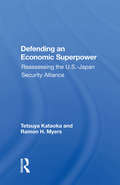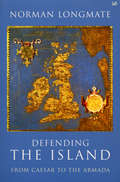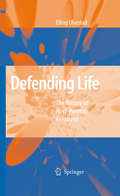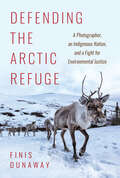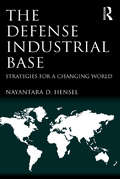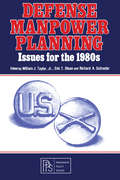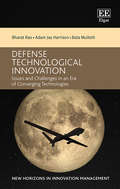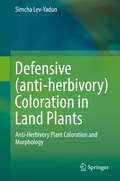- Table View
- List View
Defending Copernicus and Galileo: Critical Reasoning in the Two Affairs (Boston Studies in the Philosophy and History of Science #280)
by Maurice A. FinocchiaroAlthough recent works on Galileo’s trial have reached new heights of erudition, documentation, and sophistication, they often exhibit inflated complexities, neglect 400 years of historiography, or make little effort to learn from Galileo. This book strives to avoid such lacunae by judiciously comparing and contrasting the two Galileo affairs, that is, the original controversy over the earth’s motion ending with his condemnation by the Inquisition in 1633, and the subsequent controversy over the rightness of that condemnation continuing to our day. The book argues that the Copernican Revolution required that the hypothesis of the earth’s motion be not only constructively supported with new reasons and evidence, but also critically defended from numerous old and new objections. This defense in turn required not only the destructive refutation, but also the appreciative understanding of those objections in all their strength. A major Galilean accomplishment was to elaborate such a reasoned, critical, and fair-minded defense of Copernicanism. Galileo’s trial can be interpreted as a series of ecclesiastic attempts to stop him from so defending Copernicus. And an essential thread of the subsequent controversy has been the emergence of many arguments claiming that his condemnation was right, as well as defenses of Galileo from such criticisms. The book’s particular yet overarching thesis is that today the proper defense of Galileo can and should have the reasoned, critical, and fair-minded character which his own defense of Copernicus had.
Defending An Economic Superpower: Reassessing The U.s.-japan Security Alliance
by Tetsuya KataokaThis book describes the reassessment of the U.S.-Japan security relationship to determine how Japan can do more for its defense, reduce America's spending for Japan's and Asia's security, yet preserve the peace in that region. It raises six questions about the relationship and tries to answer them.
Defending An Economic Superpower: Reassessing The U.s.-japan Security Alliance
by Tetsuya KataokaThis book describes the reassessment of the U.S.-Japan security relationship to determine how Japan can do more for its defense, reduce America's spending for Japan's and Asia's security, yet preserve the peace in that region. It raises six questions about the relationship and tries to answer them.
Defending Hypatia: Ramus, Savile, and the Renaissance Rediscovery of Mathematical History (Archimedes #25)
by Robert GouldingWhy should mathematics, the purest of sciences, have a history? Medieval mathematicians took little interest in the history of their discipline. Yet in the Renaissance the history of mathematics flourished. This book explores how Renaissance scholars recovered and reconstructed the origins of mathematics by tracing its invention in prehistoric Antiquity, its development by the Greeks, and its transmission to modern Europe via the works of Euclid, Theon and Proclus. The principal architects of this story -- the French philosopher and University of Paris reformer Peter Ramus, and his critic, the young Oxford astronomy lecturer Henry Savile – worked out diametrically opposed models for the development of the mathematical arts, models of historical progress and decline which mirrored each scholar’s larger convictions about the nature of mathematical thinking, the purpose of the modern university, and the potential of the human mind. In their hands, the obscure story of mathematical history became a site of contention over some of the most pressing philosophical and pedagogical debates of the sixteenth century.
Defending The Island: From Caesar to the Armada
by Norman LongmateIn a brilliantly imaginative blend of military, social and diplomatic history, Norman Longmate retells our island story from the perspective of its defenders, in a narrative which stretches from the Celtic tribes who unsuccessfully fought against Ceasar to the great seabourne defence against the Armada of Philip of Spain. He has gone back to the original sources and investigated the original battlegrounds and weak spots in Britain's defences. But the real strength of his book is its seamless narrative of history, which uncovers the truth behind the legends. A mass of solidly researched fact, not readily found elsewhere, is seasoned with lively, humorous and occassionally gruesome anecdote. The result, providing at once an invaluable sourcebook for the specialist and an enthralling narrative for the general reader, is by far the most comprehensive and accessible history of England versus invasion ever published.
Defending Life: The Nature of Host-Parasite Relations
by Elling UlvestadDefending Life discusses the relationship between hosts and parasites. It contains detailed descriptions of the immune system and the microbial world as well as methodological and conceptual clarifications. Its emphasis on analytical abstractions, coherent patterns and generative mechanisms makes possible the distinction between genuine causality and coincidental associations and increases the understanding of why we observe what we observe.
Defending the Arctic Refuge: A Photographer, an Indigenous Nation, and a Fight for Environmental Justice (Flows, Migrations, and Exchanges)
by Finis DunawayTucked away in the northeastern corner of Alaska is one of the most contested landscapes in all of North America: the Arctic National Wildlife Refuge. Considered sacred by Indigenous peoples in Alaska and Canada and treasured by environmentalists, the refuge provides life-sustaining habitat for caribou, polar bears, migratory birds, and other species. For decades, though, the fossil fuel industry and powerful politicians have sought to turn this unique ecosystem into an oil field. Defending the Arctic Refuge tells the improbable story of how the people fought back. At the center of the story is the unlikely figure of Lenny Kohm (1939–2014), a former jazz drummer and aspiring photographer who passionately committed himself to Arctic Refuge activism. With the aid of a trusty slide show, Kohm and representatives of the Gwich'in Nation traveled across the United States to mobilize grassroots opposition to oil drilling. From Indigenous villages north of the Arctic Circle to Capitol Hill and many places in between, this book shows how Kohm and Gwich'in leaders and environmental activists helped build a political movement that transformed the debate into a struggle for environmental justice. In its final weeks, the Trump administration fulfilled a long-sought dream of drilling proponents: leasing much of the Arctic Refuge coastal plain for fossil fuel development. Yet the fight to protect this place is certainly not over. Defending the Arctic Refuge traces the history of a movement that is alive today—and that will continue to galvanize diverse groups to safeguard this threatened land.
Defending the Guilty: Truth and Lies in the Criminal Courtroom
by Alex McBride"As a criminal barrister, you work with the material you get: a junkie shoplifter with thirty-five previous convictions and four packs of Lidl's frozen chicken stuffed down his trousers is heading only one way..."Every day, like every criminal barrister in this country, Alex McBride stands up in court and, with nothing but quick-thinking, sharp-talking and his hard-won legal expertise, attempts to save people from criminal conviction, prison, even a lifetime behind bars. Sometimes he's had only a few hours to prepare his case. Sometimes his client is obviously guilty.In this hilarious, heart-stopping memoir, he takes us behind the scenes of Britain's criminal justice system - in barristers' chambers, in the courtroom, in the cells and on the streets - introducing us to its outlandish personalities, arcane eccentricities and its many moving stories of triumph and defeat. Whether he's defending hapless teenagers at Harlow Youth Court or prosecuting gold bullion robbers at the Bailey, his hair-raising tales reveal all the secrets of courtroom success and what it takes to survive in this chaotic world of fluked escapes and crushed hopes. Throughout he attempts to answer that most important question: how do we ensure that the guilty are convicted and the innocent walk free?
Defense against Bioterror: Proceedings of the NATO Advanced Research Workshop on Defense against Bioterror: Detection Technologies, Implementation Strategies and Commercial Opportunities, held in Madrid, Spain from 8 to 11 April 2004 (NATO Science for Peace and Security Series)
by Dennis Morrison Fred Milanovich Dmitri Ivnitski Thomas R. AustinThis is a critical assessment of breakthrough biosensor technologies that will allow for the rapid identification of biological threat agents in the environment and human population. The book provides a comprehensive overview of the current state of biological weapons threat, and reviews biosensor technologies including detection platforms, networked alarm-type biodetector systems, implementation strategies, electro-optical and electrochemical biosensors.
Defense and Recognition in the Climate Crisis: How to Communicate About Truths, Facts and Opinions
by Barbara StrohscheinTruths, facts and opinions on the climate issue are often met with psychological or social defense, both publicly and privately. Based on selected psychological and philosophical theories as well as data material, this book shows how defense comes about, how it works, and how, on the other hand, the necessary recognition can succeed on various levels. It is only through recognition that constructive discourse becomes possible. This book offers all the basics to be able to theoretically and practically solve communication conflicts between defense and recognition in the climate crisis.
The Defense Industrial Base: Strategies for a Changing World
by Nayantara HenselThe US and international defense industrial sectors have faced many challenges over the last twenty years, including cycles of growth and shrinkage in defense budgets, shifts in strategic defense priorities, and macroeconomic volatility. In the current environment, the defense sector faces a combination of these challenges and must struggle with the need to maintain critical aspects of the defense industrial base as defense priorities change and as defense budgets reduce or plateau. Moreover, the defense sector in the US is interconnected both with defense sectors in other countries and with other industry sectors in the US and global economies. As a result, strategic decisions made in one defense sector impact the defense sectors of other countries, as well as other areas of the economy. Given her academic, corporate, and Department of Defense experience as a leading economist and policy-maker, Dr. Nayantara Hensel is perfectly positioned to examine the interrelationship between these forces both historically and in the current environment, and to assess the implications for the future global defense industrial base.
The Defense Industrial Base: Strategies for a Changing World
by Nayantara HenselThe US and international defense industrial sectors have faced many challenges over the last twenty years, including cycles of growth and shrinkage in defense budgets, shifts in strategic defense priorities, and macroeconomic volatility. In the current environment, the defense sector faces a combination of these challenges and must struggle with the need to maintain critical aspects of the defense industrial base as defense priorities change and as defense budgets reduce or plateau. Moreover, the defense sector in the US is interconnected both with defense sectors in other countries and with other industry sectors in the US and global economies. As a result, strategic decisions made in one defense sector impact the defense sectors of other countries, as well as other areas of the economy. Given her academic, corporate, and Department of Defense experience as a leading economist and policy-maker, Dr. Nayantara Hensel is perfectly positioned to examine the interrelationship between these forces both historically and in the current environment, and to assess the implications for the future global defense industrial base.
Defense Industries: Science and Technology Related to Security: Impact of Conventional Munitions on Environment and Population (Nato Science Series: IV: #44)
by Pelagio Castelo Branco Hiltmar Schubert Jose CamposThe state of the art in the area of security related civil science and technology concerning energetic materials and munitions is of pressing importance at the present time, because 10 years after the end of the cold war, in many countries in east and west, huge stockpiles of munitions still await destruction. The safety behavior of munitions and their energetic material is the determining factor for all precautionary measures for the protection of environment and population. The probability of a catastrophic reaction of munitions and their energetic components will be so more likely, the closer the munitions are to the end of their life time. Residues and undetected ordnance, recycling, destruction of ammunition and depletion or reuse of energetic materials will either cause more or less damage to environment. Scientific research and development have the aim to increase performance of munitions on one side and to improve safety in relation to unpredictable events on the other side. The impact on the environment by the production and normal use of munitions and their residues after use will acquire an increasing importance in environmental awareness. The excellent technical presentations were classified in five Groups, according to the technical programme. The "Introduction to the subject; Methods, tests and application; Insensitive and "green" munitions; Storage and transportation; and Demilitarisation and recycling" sessions, were closed by a final and general interesting discussion among participants.
Defense Manpower Planning: Issues for the 1980s
by William J. Taylor Eric T. Olson Richard A. SchraderDefense Manpower Planning discusses the important set of national security issues related to defense manpower for the 1980s. The topics in the text focus on the problems of manpower acquisition and retention. The historical background and description of the military power during the 1970s and 1980s are given in detail. A military manpower chronology is provided. The book enumerates some of the manpower issues and debates. Such salient issues as the quantity, quality, socio-economic factors, and the issue of cost, combat effectiveness, and readiness factors are carefully considered. After listing the issues, solutions are then presented. The variants of the all-volunteer force, of conscription, and combining volunteers and conscripts are suggested. A part of the book focuses on active duty forces. The issue of employing women in the military is fully addressed. A description of combat is also tackled. A section of the text explains the relationship between precision guided munitions and the volunteer force. The book will provide useful information to defense military planners, historians, and students of history.
Defense Mechanisms of Woody Plants Against Fungi (Springer Series in Wood Science)
by Robert A. Blanchette Alan R. BiggsFor the past decade, it has been apparent to both of us that a reference text covering all aspects of tree defense mechanisms to fungi was missing, needed and long overdue. Such a book would provide a clear, comprehensive overview of how living roots, stems and leaves respond to fungal pathogens. The need for such a book became in creasingly clear to us from our conversations with each other, as well as from our interactions with students and colleagues who desired a sourcebook containing reviews of morphological, biochemical and physiological aspects of host-parasite interactions in trees. During a field trip sponsored by the Forest Pathology Committee of the Ameri can Phytopathological Society, on a bus from one site to another, we decided to take the responsibility to prepare a book of this type and began to plan its composition. To adequately address the topic of this book as we had envisioned it, we believed that well-illustrated chapters were needed in order to reflect the important advances made by the many investigators who have examined the anatomical and physiological changes that occur when trees are attacked by fungi. We are grateful to Dr. Tore Timell, the Wood Science editor for Springer-Verlag, for supporting our efforts and for providing an avenue to publish such a profusely il lustrated volume.
Defense of Mucosal Surfaces: Pathogenesis, Immunity and Vaccines (Current Topics in Microbiology and Immunology #236)
by Marian R. Neutra Jean-PierreKraehenbuhlMucosal immunity encompasses a broad field of research that includes areas of epithelial cell and molecular biology, molecular and cellular immunology, microbiology, virology, and vaccinology. This volume presents up to date and concise discussions of concepts as well as recent advances. It provides an overview of the components of the mucosal immune system, and the basic science relevant to mucosal vaccination. The authors assess current research in critical areas including: Organization of mucosal lymphoid tissue; antigen sampling and presentation in mucosal tissues; mucosalimmune responses and tolerance; immune effectors at mucosal sites; microbial-host interactions at mucosal sites; mucosal vaccines and adjuvants. This multi-disciplinary effort will be a valuable resource for researchers, clinicians and students who need a clear understanding of concepts and a guide to the wide-ranging literature in this very active research area.
A Defense of Simulated Experience: New Noble Lies (Routledge Studies in Contemporary Philosophy)
by Mark SilcoxThis book defends an account of the positive psychological, ethical, and political value of simulated human experience. Philosophers from Plato and Augustine to Heidegger, Nozick, and Baudrillard have warned us of the dangers of living on too heavy a diet of illusion and make-believe. But contemporary cultural life provides broader, more attractive opportunities to do so than have existed at any other point in history. The gentle forms of self-deceit that such experiences require of us, and that so many have regarded as ethically unwholesome or psychologically self-destructive, can in fact serve as vital means to political reconciliation, cultural enrichment, and even (a kind of) utopia. The first half of the book provides a highly schematic definition of simulated experience and compares it with some claims about the nature of simulation made by other philosophers about what it is for one thing to be a simulation of another. The author then provides a critical survey of the views of some major authors about the value of certain specific types of simulated experience, mainly in order to point out the many puzzling inconsistencies and ambiguities that their thoughts upon the topic often exhibit. In the second half of the book, the author defends an account of the positive social value of simulated experience and compares his own position to the ideas of a number of utopian political thinkers, as well as to Plato's famous doctrine of the "noble lie." He then makes some tentative practical suggestions about how a proper appreciation of the value of simulated experience might influence public policy decisions about such matters as the justification of taxation, paternalistic "choice management," and governmental transparency. A Defense of Simulated Experience will appeal to a broad range of philosophers working in normative ethics, aesthetics, the philosophy of technology, political philosophy, and the philosophy of culture who are interested in questions about simulated experience. The book also makes a contribution to the emerging field of Game Studies.
A Defense of Simulated Experience: New Noble Lies (Routledge Studies in Contemporary Philosophy)
by Mark SilcoxThis book defends an account of the positive psychological, ethical, and political value of simulated human experience. Philosophers from Plato and Augustine to Heidegger, Nozick, and Baudrillard have warned us of the dangers of living on too heavy a diet of illusion and make-believe. But contemporary cultural life provides broader, more attractive opportunities to do so than have existed at any other point in history. The gentle forms of self-deceit that such experiences require of us, and that so many have regarded as ethically unwholesome or psychologically self-destructive, can in fact serve as vital means to political reconciliation, cultural enrichment, and even (a kind of) utopia. The first half of the book provides a highly schematic definition of simulated experience and compares it with some claims about the nature of simulation made by other philosophers about what it is for one thing to be a simulation of another. The author then provides a critical survey of the views of some major authors about the value of certain specific types of simulated experience, mainly in order to point out the many puzzling inconsistencies and ambiguities that their thoughts upon the topic often exhibit. In the second half of the book, the author defends an account of the positive social value of simulated experience and compares his own position to the ideas of a number of utopian political thinkers, as well as to Plato's famous doctrine of the "noble lie." He then makes some tentative practical suggestions about how a proper appreciation of the value of simulated experience might influence public policy decisions about such matters as the justification of taxation, paternalistic "choice management," and governmental transparency. A Defense of Simulated Experience will appeal to a broad range of philosophers working in normative ethics, aesthetics, the philosophy of technology, political philosophy, and the philosophy of culture who are interested in questions about simulated experience. The book also makes a contribution to the emerging field of Game Studies.
Defense of the Scientific Hypothesis: From Reproducibility Crisis to Big Data
by Bradley E. AlgerDefense of Scientific Hypothesis: From Reproducibility Crisis to Big Data sets out to explain and defend the scientific hypothesis. Alger's mission is to counteract the misinformation and misunderstanding about the hypothesis that even seasoned scientists have concerning its nature and place in modern science. Most biological scientists receive little or no formal training in scientific thinking. Further, the hypothesis is under attack by critics who claim that it is irrelevant to science. In order to appreciate and evaluate scientific controversies like global climate change, vaccine safety, etc., the public first needs to understand the hypothesis. Defense of Scientific Hypothesis begins by describing and analyzing the scientific hypothesis in depth and examining its relationships to various kinds of science. Alger then guides readers through a review of the hypothesis in the context of the Reproducibility Crisis and presents survey data on how scientists perceive and employ hypotheses. He assesses cognitive factors that influence our ability to use the hypothesis and makes practical and policy recommendations for teaching and learning about it. Finally, Alger considers two possible futures of the hypothesis in science as the Big Data revolution looms: in one scenario, the hypothesis is displaced by the Big Data Mindset that forgoes understanding in favor of correlation and prediction. In the other, robotic science incorporates the hypotheses into mechanized laboratories guided by artificial intelligence. But in his illuminating epilogue, Alger envisions a third way, the Centaur Scientist, a symbiotic relationship between human scientists and computers.
Defense of the Scientific Hypothesis: From Reproducibility Crisis to Big Data
by Bradley E. AlgerDefense of Scientific Hypothesis: From Reproducibility Crisis to Big Data sets out to explain and defend the scientific hypothesis. Alger's mission is to counteract the misinformation and misunderstanding about the hypothesis that even seasoned scientists have concerning its nature and place in modern science. Most biological scientists receive little or no formal training in scientific thinking. Further, the hypothesis is under attack by critics who claim that it is irrelevant to science. In order to appreciate and evaluate scientific controversies like global climate change, vaccine safety, etc., the public first needs to understand the hypothesis. Defense of Scientific Hypothesis begins by describing and analyzing the scientific hypothesis in depth and examining its relationships to various kinds of science. Alger then guides readers through a review of the hypothesis in the context of the Reproducibility Crisis and presents survey data on how scientists perceive and employ hypotheses. He assesses cognitive factors that influence our ability to use the hypothesis and makes practical and policy recommendations for teaching and learning about it. Finally, Alger considers two possible futures of the hypothesis in science as the Big Data revolution looms: in one scenario, the hypothesis is displaced by the Big Data Mindset that forgoes understanding in favor of correlation and prediction. In the other, robotic science incorporates the hypotheses into mechanized laboratories guided by artificial intelligence. But in his illuminating epilogue, Alger envisions a third way, the Centaur Scientist, a symbiotic relationship between human scientists and computers.
Defense Technological Innovation: Issues and Challenges in an Era of Converging Technologies (New Horizons in Innovation Management series)
by Bharat Rao Adam J. Harrison Bala MullothRapid advances in the technologies of the Fourth Industrial Revolution pose a critical challenge to large, complex organizations both in the private and public sectors. The national defense ecosystem is no exception. The US Department of Defense has launched a number of efforts directed towards fostering creative and entrepreneurial problem solving, while evolving better practices to absorb external innovations. Defense Technological Innovation describes the emerging paradigm for innovation at the US Department of Defense, and the consequential impacts on its stakeholders. Leveraging a combination of prior research, archival data, first-person observations and interviews, the authors identify practices and themes characterizing the key trends in defense innovation, describe current organizational approaches and practices, and develop a theoretical framework that elucidates the competencies required to underwrite defense innovation objectives. The findings therein are relevant to any large, technology-driven organization contending with the implications of rapid change in the high-tech landscape. Scholars interested in the broad areas of technology innovation, national security, defense policy, and organizational change now have a book that addresses the problem of defense innovation. It will also appeal to scholars and policymakers in strategy, security studies, international affairs, and policy.
Defensive (anti-herbivory) Coloration in Land Plants: Anti-herbivory Plant Coloration And Morphology
by Simcha Lev-YadunThis book presents visual plant defenses (camouflage, mimicry and aposematism via coloration, morphology and even movement) against herbivores. It is mainly an ideological monograph, a manifesto representing my current understanding on defensive plant coloration and related issues. The book is not the final word in anything, but rather the beginning of many things. It aims to establish visual anti-herbivory defense as an integral organ of botany, or plant science as it is commonly called today. I think that like in animals, many types of plant coloration can be explained by selection associated with the sensory/cognitive systems of herbivores and predators to reduce herbivory. It is intended to intrigue and stimulate students of botany/plant science and plant/animal interactions for a very long time. This book is tailored to a readership of biologists and naturalists of all kinds and levels, and more specifically for botanists, ecologists, evolutionists and to those interested in plant/animal interactions. It is written from the point of view of a naturalist, ecologist and evolutionary biologist that I hold, considering natural selection as the main although not the only drive for evolution. According to this perspective, factors such as chance, founder effects, genetic drift and various stochastic processes that may and do influence characters found in specific genotypes, are not comparable in their power and influence to the common outcomes of natural selection, especially manifested when very many species belonging to different plant families, with very different and separate evolutionary histories, arrive at the same adaptation, something that characterizes many of the visual patterns and proposed adaptations described and discussed in this book. Many of the discussed visual defensive mechanisms are aimed at operating before the plants are damaged, i.e., to be their first line of defense. In this respect, I think that the name of the book by Ruxton et al. (2004) "Avoiding Attack" is an excellent phrase for the assembly of the best types of defensive tactics. While discussing anti-herbivory, I do remember, study and teach physiological/developmental aspects of some of the discussed coloration patterns, and I am fully aware of the simultaneous and diverse functions of many plant characters in addition to defense.
Defensive ohne Alternative: Kategorischer Imperativ und militärische Macht
by Lutz UnterseherLutz Unterseher geht der Frage nach, welche Art militärischer Rüstung mit dem Ziel vereinbar ist, bewaffnete Konflikte zu vermeiden oder zumindest zu begrenzen.
Defensive Tactics for Today’s Law Enforcement
by Stephen K. Hayes Joe NiehausFew of the many defensive tactics books on the market include the training and methods of martial arts. Drawing on the centuries-old techniques of Ninjutsu, Defensive Tactics for Today’s Law Enforcement offers alternatives to the traditional police defensive tactics taught to most officers. This text stresses relying on natural tendencies in a violent encounter to ensure officer safety and to better utilize the techniques and training officers do receive. By integrating existing training with martial arts expertise, Defensive Tactics provides officers access a full complement of techniques to better navigate physical conflict safely and effectively. Intended for law enforcement practitioners, as well as practitioners of any other professions that present a personal security risk, Defensive Tactics for Today’s Law Enforcement will better equip readers with a diverse range of defensive tactics.
Defensive Tactics for Today’s Law Enforcement
by Stephen K. Hayes Joe NiehausFew of the many defensive tactics books on the market include the training and methods of martial arts. Drawing on the centuries-old techniques of Ninjutsu, Defensive Tactics for Today’s Law Enforcement offers alternatives to the traditional police defensive tactics taught to most officers. This text stresses relying on natural tendencies in a violent encounter to ensure officer safety and to better utilize the techniques and training officers do receive. By integrating existing training with martial arts expertise, Defensive Tactics provides officers access a full complement of techniques to better navigate physical conflict safely and effectively. Intended for law enforcement practitioners, as well as practitioners of any other professions that present a personal security risk, Defensive Tactics for Today’s Law Enforcement will better equip readers with a diverse range of defensive tactics.

